Hydroponic Indoor Grow Box: Your Ultimate Guide
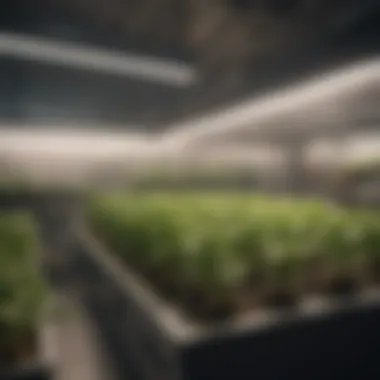
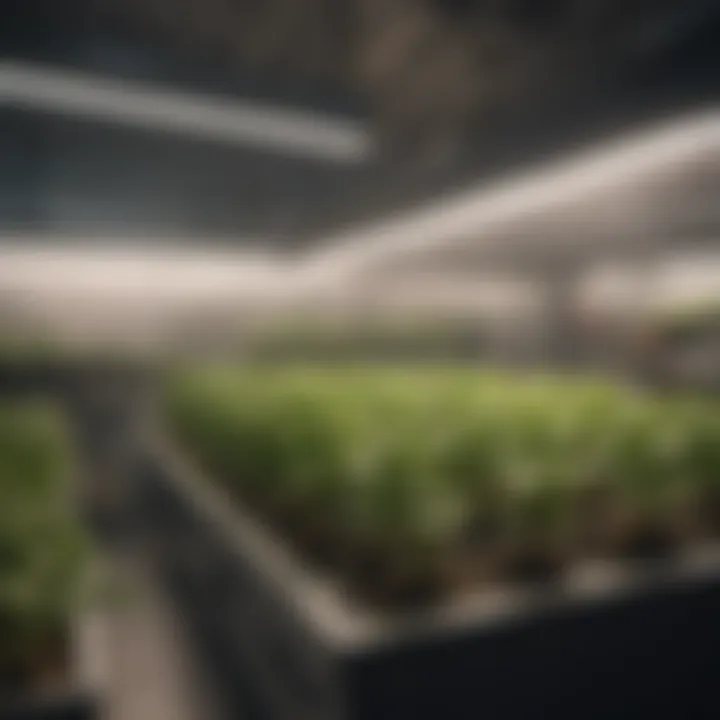
Topic Overview
Definition and Importance
Hydroponic indoor grow boxes represent a modern solution in agricultural innovation, allowing individuals to cultivate plants without soil. This method involves a nutrient-rich solution being delivered directly to the plant roots, facilitating growth in a controlled environment. These grow boxes are significant for urban gardening, as they allow for efficient use of space and resources. They can be essential for people looking to grow their own food, particularly in areas where traditional gardening may not be feasible.
Brief History and Evolution
The concept of hydroponics has been around for centuries, but it gained traction in the 20th century with advancements in agricultural science. The term 'hydroponics' itself came from the Greek words for "water" and "working," emphasizing the fundamental role of water in this growing method. Over the years, the evolution of hydroponic systems has led to the creation of various types of grow boxes, each designed for specific plants and growing conditions. With the rise of technology, these systems have also become more sophisticated, incorporating automated features that assist growers in maintaining the optimal environment for plant development.
Key Techniques and Innovations
Sustainable Farming Practices
The adoption of hydroponic systems aligns with sustainable farming practices. Using a grow box can considerably reduce water usage compared to traditional farming methods. It allows for recycling of the nutrient solution and minimizes runoff, which can contribute to environmental pollution. By enabling year-round growing, individuals can enjoy fresh produce without the negative impacts of seasonal farming.
Advanced Agronomic Technologies
With developing technologies, hydroponic systems now feature innovations such as smart monitoring systems, LED grow lights, and automated nutrient dosing. These advancements ensure that growers can maintain the perfect conditions for their plants with minimal effort. By integrating technology, it is now easier to track plant health, optimize growth conditions, and enhance overall productivity in indoor environments.
Practical Applications
Step-by-Step Guides
To successfully start a hydroponic garden, one must first choose a suitable grow box. Once acquired, set it up in a location with sufficient light or utilize grow lights. Fill the reservoir with water and a hydroponic nutrient solution. Next, prepare the plants for growing by germinating seeds in a starter medium. Transplant them into the grow box, ensuring the roots are adequately submerged in the nutrient solution while the top part remains exposed.
Case Studies or Real-World Examples
Many urban dwellers have turned to hydroponic grow boxes to cultivate fresh herbs and vegetables in small spaces, like apartments and rooftops. For instance, an urban farmer in New York City transformed a small balcony into a thriving hydroponic garden, yielding fresh basil and tomatoes year-round. This example showcases how practical and effective hydroponic systems can be for individuals eager to grow their own food despite limited space.
Hydroponics can dramatically change how we approach urban agriculture and personal gardening.
By understanding the basic principles of hydroponic indoor grow boxes, growers can make informed choices and optimize their indoor gardening potential. The integration of technology and sustainable practices will play a crucial role in future agricultural methodologies.
Prelims to Hydroponics
The realm of hydroponics has gained significant attention in recent years, particularly among agriculture farmers and gardening enthusiasts. Understanding the foundations of hydroponics serves as an essential precursor to exploring the efficient use of indoor grow boxes. Hydroponics, at its core, encompasses growing plants in a soil-less environment using nutrient-rich water solutions. This innovative approach not only allows for year-round cultivation but also enables optimization of space and resources.
Definition of Hydroponics
Hydroponics can be defined as the method of growing plants without soil, utilizing a mineral-rich water solution instead. In this system, plants receive essential nutrients directly through their roots. The absence of soil eliminates many common gardening challenges, such as pests and diseases associated with the growing medium. This method offers a controlled environment that is particularly advantageous for indoor gardening, where conditions can be manipulated to optimize growth.
Historical Background
The concept of hydroponics has roots that trace back thousands of years. Ancient civilizations, including the Babylonians, utilized similar methods to cultivate crops in hanging gardens. However, it was not until the 20th century that hydroponics began to formally develop as a science. Significant advancements came during World War II when researchers sought ways to grow food in limited spaces. Today, hydroponics is widely recognized as a sustainable alternative for food production, attracting interest from both commercial and home growers.
Advantages of Hydroponic Systems
The advantages of hydroponic systems are manifold. First and foremost, they allow for accelerated plant growth due to the direct access to nutrients and increased oxygen levels in the root system. This can result in higher yields within a shorter time frame when compared to traditional soil gardening. Additionally, hydroponics often requires less water than conventional methods, a vital benefit in regions facing water scarcity. The controlled nature of hydroponic systems significantly reduces the risk of pests and diseases, thus minimizing the need for chemical pesticides.
Benefits of hydroponic systems include:
- Space Efficiency: Ideal for urban environments where space is limited.
- Resource Conservation: Uses up to 90% less water than soil gardening.
- Year-Round Production: Allows for continuous cultivation regardless of seasonal changes.
- Reduced Labor: Less weeding and maintenance are required compared to traditional farming practices.
Hydroponics represents a shift towards innovative agricultural practices, emphasizing sustainability and efficiency in food production.
Understanding these foundational elements of hydroponics sets the stage for a deeper exploration into indoor grow boxes and their applications in modern gardening.
Understanding Indoor Grow Boxes
Indoor grow boxes represent a pivotal element in the world of hydroponics. These compact and controlled environments offer a unique solution for cultivating plants without the need for soil. Understanding the intricacies of indoor grow boxes allows growers to harness the benefits of hydroponic systems efficiently. The article will illustrate how these boxes can optimize growth potential, ensure plant health, and adapt to various indoor settings.
What is an Indoor Grow Box?
An indoor grow box is a self-contained system designed to support plant growth in an enclosed space. This structure provides a controlled environment where factors like light, temperature, and humidity can be tailored to the specific needs of plants. They are often compact enough to fit in homes or apartments, making gardening accessible even in urban settings. The design can vary, from DIY setups to pre-assembled units, each catering to different experience levels and goals.
Basic Components of a Grow Box
Understanding the specific components of a grow box is essential for maximizing its potential. Each part must be carefully considered and integrated into the system.
Growing chamber
The growing chamber is the heart of an indoor grow box. It is where plants reside and develop. The critical aspect of the growing chamber is its size and design, which can affect airflow and plant growth. A well-insulated chamber helps maintain optimal temperatures, ensuring that crops can thrive. A common feature is adjustable shelving, which allows growers to modify the height according to the plant’s growth. While efficient, one disadvantage might be the initial cost of setting up a properly insulated chamber.
Lighting system
The lighting system plays a crucial role in indoor gardening. Proper lighting stimulates photosynthesis and influences plant growth patterns. LED grow lights are often favored due to their energy efficiency and spectrum customization. The unique feature of a quality lighting system is the ability to mimic natural sunlight conditions. However, a disadvantage could be the upfront cost and need for regular adjustments as plants grow larger.
Ventilation
Ventilation is a vital component that promotes healthy air circulation within the grow box. Good ventilation helps prevent mold growth and maintains CO2 levels necessary for photosynthesis. Features such as exhaust fans or passive vents allow for airflow management. Suitable ventilation is beneficial for temperature control, ensuring that the internal environment does not become too humid or hot. On the downside, improperly configured ventilation can lead to drafts that may harm sensitive plants.
Water reservoir
The water reservoir is where nutrient solutions are stored and delivered to plants in hydroponic systems. An efficient water reservoir maintains constant access to moisture while ensuring that plants receive the necessary nutrients. Key characteristics include the material used and the volume capacity, influencing the frequency of refill requirements. A good reservoir design can provide adequate oxygenation of water, which is essential for root health. However, a disadvantage may be the need for regular checks to prevent algal growth or contamination.
A well-assembled indoor grow box integrates these components, ensuring the success of a hydroponic setup.
Understanding how each of these components functions within the grow box system is vital for any hydroponics enthusiast aiming to improve their plant yields.
Types of Hydroponic Systems for Grow Boxes
Understanding the various hydroponic systems is crucial for anyone interested in managing a grow box. Each system has its unique characteristics, advantages, and potential downsides. By selecting the appropriate hydroponic method, growers can enhance their indoor gardening experience. Some systems are easier to establish and maintain than others, making them suitable for beginners. In this section, we will explore four notable hydroponic systems that can be effectively used in indoor grow boxes: Deep Water Culture, Nutrient Film Technique, Ebb and Flow Systems, and Aeroponic Systems.
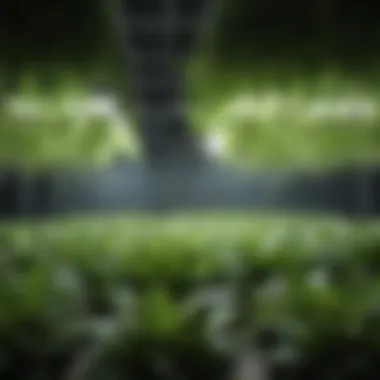

Deep Water Culture (DWC)
Deep Water Culture is one of the simplest and most efficient hydroponic systems available. In this method, plant roots are submerged in a nutrient-rich water solution, which is aerated using an air pump and air stones. This process supplies ample oxygen directly to the roots, which is essential for their growth. DWC systems are relatively easy to set up and offer rapid plant growth due to the constant availability of nutrients and oxygen.
Some key advantages of DWC include:
- Rapid Growth: The roots receive continuous access to nutrients and oxygen, leading to faster growth rates compared to soil-based methods.
- Low Maintenance: Once set up, DWC systems require minimal maintenance except for monitoring pH and nutrient levels.
- Cost-Effectiveness: Relative to other hydroponic systems, DWC setups can be built affordably and use fewer materials.
However, growers should be aware of potential challenges like:
- Temperature Sensitivity: Water temperatures need to be managed, as excessive heat may harm the roots and disrupt oxygen saturation.
- System Failures: Power outages or pump failures can quickly harm plants if they are not monitored closely.
Nutrient Film Technique (NFT)
The Nutrient Film Technique is characterized by a thin film of nutrient solution flowing over the roots of plants. This system uses a slight slope in the growing channel to ensure the nutrients circulate without drowning the roots. NFT systems are efficient, as they use less water and nutrients than traditional methods.
Advantages of NFT systems include:
- Water Efficiency: Since the solution circulates continuously, water usage is minimal, making it eco-friendly.
- Customizable: NFT setups can be designed to fit different spaces and plant types, offering flexibility for growers.
On the downside, NFT systems require:
- Constant Monitoring: The delicate balance of nutrient concentration and flow must be maintained, necessitating regular checks.
- Susceptibility to Blockages: Any interruption in the flow can quickly affect root health and plant growth.
Ebb and Flow Systems
Ebb and Flow systems, also known as flood and drain systems, work by periodically flooding the grow bed with nutrient solution and then draining it back into a reservoir. This method allows plant roots to soak up nutrients and oxygen during the flood phase and prevents waterlogging during the drain phase. It is versatile and can be adapted for various plants.
Notable benefits of Ebb and Flow systems include:
- Improved Root Development: The alternating cycles of flooding and draining help promote oxygen exchange at the root zone.
- Versatility: This system can accommodate both small and large plants effectively.
However, they also present challenges such as:
- Pump Dependency: Any failure of the pump can disrupt the entire growing cycle, impacting plant health.
- Complex Setup: More components and setup requirements make them somewhat complicated for beginners.
Aeroponic Systems
Aeroponic systems are among the most advanced hydroponic methods. In aeroponics, plant roots hang in the air and are misted with nutrient solution at intervals. This setup maximizes oxygen exposure, potentially leading to rapid growth rates and higher yields. Aeroponics is often used for specific crops like herbs and lettuces but is suitable for various plants when managed correctly.
Key benefits include:
- Optimal Oxygen Availability: The roots have constant access to oxygen, which is essential for healthy plant growth.
- Space Efficiency: This method requires less space than traditional hydroponics, making it ideal for small indoor grow boxes.
Nevertheless, aeroponic systems can be prone to:
- Technical Complexity: The intricate design requires precise control over misting schedules and nutrient delivery, as any failure can drastically affect plants.
- Higher Initial Investment: These systems usually have a higher setup cost, especially when utilizing advanced technologies.
In summary, choosing the right hydroponic system is essential for success in indoor gardening. Each system has its strengths and weaknesses, which must be aligned with the grower's experience and goals. By understanding the differences between DWC, NFT, Ebb and Flow, and Aeroponic systems, growers can make informed decisions that enhance their productivity and enjoyment in indoor gardening.
Building Your Hydroponic Indoor Grow Box
Building your own hydroponic indoor grow box is a crucial part of creating a successful indoor growing environment. As urban and indoor gardening gains popularity, understanding the construction process can empower growers. By tailoring the grow box to specific needs, growers can achieve better control over plant health and yield.
One key aspect of this process is flexibility. You can modify the size and components based on available space and types of plants. This tailored approach can significantly enhance the growth potential of your chosen crops, making it a favored choice for both novice and experienced growers.
Another important benefit is the opportunity for learning. By constructing the grow box, you gain firsthand knowledge of the system's requirements. Understanding how components like lighting and irrigation systems work together will help optimize their functions, leading to improved results.
Materials Needed
To build an effective hydroponic indoor grow box, certain materials are essential. These materials ensure that your system functions well, supports plant health, and lasts over time. Here are some of the basic components you will need:
- Growing chamber: This is where your plants will grow. It should be made from durable, non-toxic materials.
- Lighting system: Choose grow lights that emit the right spectrum for plant growth.
- Ventilation equipment: Ensure proper airflow to prevent heat buildup and maintain oxygen levels.
- Water reservoir: This holds the nutrient solution essential for the plants' growth.
- Hydroponic medium: Such as rock wool or clay pellets, to support plant roots.
These materials should be carefully selected to optimize the efficiency of your grow box setup.
Step-by-Step Assembly
Constructing the frame
Constructing the frame is one of the first steps in assembly. A strong frame ensures stability for all components. Typically, wood or metal is used for this purpose. Choosing high-quality materials minimizes the risk of warping or collapsing under weight, which can be crucial when your plants mature.
The design of the frame should allow for adequate ventilation and access for maintenance. A box-shaped structure offers convenience for most growers. Additionally, remember that the frame must support not just the plants, but also the lighting and any other systems you plan to integrate.
Installing the lighting
Installing the lighting is a critical step. The light must be positioned to provide adequate coverage for all plants. LED grow lights are often favored due to their efficiency and reduced heat output. This characteristic is beneficial in an indoor setting, where excessive heat can stress plants.
Positioning the lights at an appropriate height helps prevent burning tender leaves, while still ensuring enough intensity for growth processes. It's common to install adjustable fixtures so that lighting can be moved as plants grow, maintaining optimal distance.
Setting up the irrigation system
Setting up the irrigation system ensures that plants receive the correct amount of nutrient solution. You can choose between drip systems and deep water culture, depending on your preference and the chosen plants. The key characteristic here is consistency in delivering nutrients and water.
When properly set, the system should minimize both overwatering and underfeeding. This precision contributes significantly to the overall success of your growing endeavors.
Calibrating the environment
Calibrating the environment is crucial for optimal plant growth. This phase involves adjusting light, temperature, and humidity. Control equipment such as thermostats and hygrometers can assist in this process.
The primary goal is to create a stable environment that mimics ideal conditions. For example, certain plants thrive in higher humidity levels, while others prefer drier settings. Adjusting conditions based on the specific needs of your plants can greatly affect their health and yields.
"Creating the right environment is as important as choosing the right plants. Understanding and controlling factors can lead to success in hydroponic gardening."
Optimal Conditions for Plant Growth
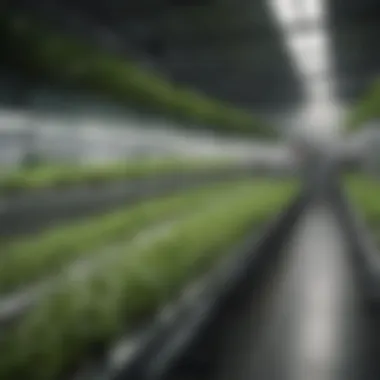
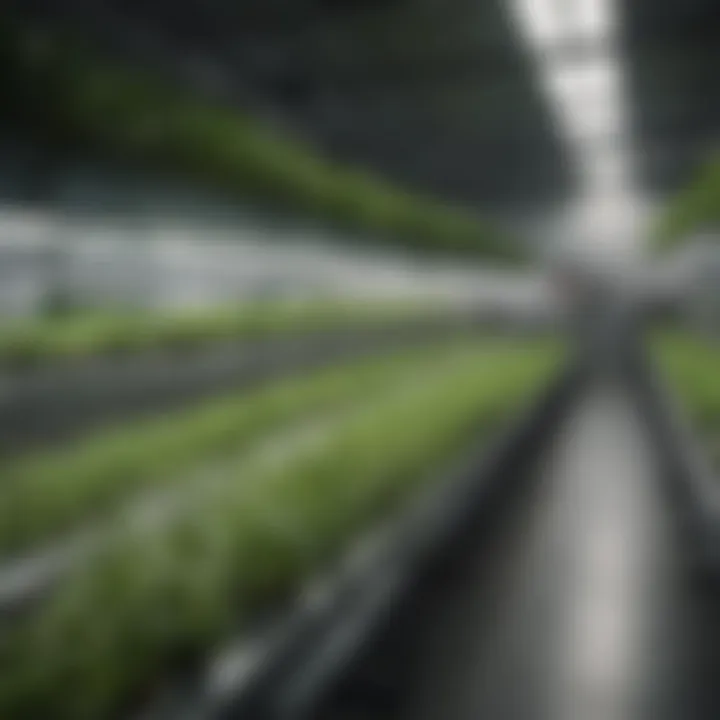
Creating optimal conditions for plant growth is essential in hydroponic systems. Plants require specific environmental factors to thrive. These include light, nutrients, temperature, and humidity. Understanding these elements can significantly influence the success of your indoor grow box. Meeting these conditions allows for healthier plants and higher yields.
Light Requirements
Light plays a crucial role in photosynthesis, which is the process plants use to convert light energy into chemical energy. In hydroponic systems, the right type of light is fundamental for growth.
Types of grow lights
There are various types of grow lights available. Each type has its unique characteristics and benefits. For hydroponics, the most common options are:
- LED Grow Lights: Energy-efficient and have a long lifespan. They provide specific wavelengths that plants need for growth.
- HID Lights (High-Intensity Discharge): These include metal halide and HPS lights. HID lights are powerful and effective for intense lighting needs, but they generate more heat.
- Fluorescent Lights: These are suitable for seedlings and low-light plants. They are less energy-intensive but may not be sufficient for all growth stages.
The choice of light can impact the efficiency of your grow box. For instance, LED lights minimize energy costs and heat, making them popular for small indoor setups.
Light duration and intensity
The duration and intensity of light affect plant growth directly. Most plants need about 12 to 18 hours of light daily during the vegetative stage. For flowering, a reduction to 10 to 12 hours may be required.
Intensity also matters. Higher light intensity can lead to faster growth, but it can also cause light stress if too intense. Therefore, understanding your plants and adjusting light levels is critical.
Nutrient Solutions
Nutrient solutions are vital because plants do not encounter soil. They rely on an enriched water system. A proper nutrient solution has the necessary macro and micronutrients. Common elements include nitrogen, phosphorus, potassium, calcium, magnesium, and various trace elements. These nutrients support plant growth, development, and yield. Regular testing of these solutions ensures plants receive what they need for optimal growth.
Temperature Control
Temperature control is essential in a hydroponic environment. The ideal temperature range typically falls between 65°F and 75°F (18°C - 24°C) for most crops. Too high or too low temperatures can lead to stress, impacting plant development. Monitoring temperature helps to create a stable environment for plant growth. Using thermometers and thermostats can assist in maintaining the desired temperature ranges.
Humidity Levels
Humidity also plays an important role in plant growth. For most plants, relative humidity should be kept between 40% and 60%. Higher humidity can lead to fungal diseases, while too low humidity can cause plants to wilt. It is important to monitor humidity levels in the grow box and make adjustments accordingly, using dehumidifiers or humidifiers as necessary.
Maintaining optimal conditions is key to successful hydroponic gardening. By carefully managing light, nutrients, temperature, and humidity, you can ensure your plants thrive.
Choosing Plants for Hydroponic Grow Boxes
Selecting the right plants is crucial for the success of a hydroponic system. Different plants have distinct requirements for light, nutrients, and water. Choosing plants that thrive in hydroponic environments will directly influence yield and overall health. Understanding which plants are best suited for your indoor grow box helps you optimize the available resources and space.
A careful selection ensures that beginners can handle the learning curve while minimizing risks associated with plant failure. Moreover, advanced growers can experiment with various species, increasing diversity and cultivating their knowledge further.
Best Plants for Beginners
For those new to hydroponics, starting with easy-to-grow plants can provide a confident introduction to this gardening method.
- Lettuce: It grows quickly, matures in a few weeks, and does not require intense light.
- Spinach: Similar to lettuce, spinach is fast-growing and can be harvested multiple times.
- Herbs: Such as basil, mint, or parsley; these plants are not only simple to grow but also add flavor to meals.
- Kale: This leafy green is resilient and offers a nutritional boost to your diet.
Choosing these plants allows beginners to understand the fundamentals of hydroponics while enjoying quick satisfaction.
Herbs vs. Vegetables
Deciding between growing herbs or vegetables can shape your hydroponic experience.
Benefits of herbs include:
- They mature quickly, providing faster results.
- Many herb species can thrive in smaller spaces, making them ideal for indoor gardens.
- They can improve the flavor of dishes, offering culinary satisfaction.
On the other hand, vegetables, like tomatoes or peppers, require more space and attention but can yield more substantial harvests.
- Their growth period is typically longer, allowing for a more extended engagement with the growing process.
- Vegetables can contribute significantly to a balanced diet, making them a worthwhile investment.
Ultimately, the choice between herbs and vegetables should align with personal preferences and your capacity to dedicate time and resources to your hydroponic setup.
Maintenance of Hydroponic Systems
Maintaining a hydroponic system is essential for ensuring optimal plant growth. Regular maintenance prevents common issues and enhances system performance. Without proper care, plants can suffer from nutrient deficiencies, poor growth, or diseases. Good maintenance practices provide consistency, making the hydroponic system more effective.
Regular Monitoring
Monitoring is a vital part of hydroponics maintenance. This process involves checking nutrient levels, pH, and water quality consistently. Notably, plants require specific nutrient concentrations. If nutrients run low, growth can stall or deteriorate. Regularly test the water to ensure the right balance. A pH level between 5.5 and 6.5 is ideal for most plants in a hydroponic setup. Keep logs of these measurements to track changes over time.
In addition, watch for any signs of stress in plants. Yellowing leaves, stunted growth, or wilting indicate a problem. Quick action can often save the plants from more serious issues. Always visually inspect the water source for clarity and any unwanted debris.
Cleaning and Sanitation
Keeping a clean system is vital to prevent build-up of pathogens and algae. Cleaning should be done regularly, especially the reservoirs and grow media. Use a solution of water and mild bleach to disinfect surfaces. Rinse thoroughly, ensuring no residues remain, which can harm plants.
Schedule a cleaning routine, perhaps every month or after every cycle of crop. During the cleaning, check all system parts. Replace any filters if necessary. Cleanliness in a hydroponic system protects plant health and promotes efficient nutrient uptake.
Pest and Disease Management
Managing pests and diseases is crucial in hydroponics. These threats can spread quickly in a controlled environment. Regularly assess plants for any signs of pests, such as larvae or webbing. Understand common pests like aphids, spider mites, and whiteflies. Use natural insecticides or neem oil to combat these pests when detected before they cause significant damage.
For diseases, prevention is key. Proper air circulation and lighting help reduce humidity, minimizing disease risk. If an outbreak occurs, isolate affected plants immediately. Apply fungicides or other treatments as necessary. Education on identifying and managing pests and diseases ensures the long-term success of a hydroponic system.
Technological Innovations in Hydroponics
Technological innovation plays a crucial role in the evolution of hydroponic systems. As indoor gardening gains popularity, integrating advanced technologies offers several advantages, such as increased efficiency and productivity. Innovations in hydroponics create ways for growers to optimize their systems, leading to better plant growth and yield.
One key area of advancement is automation, which allows for effortless management of the growing environment. Sensors help monitor various factors like nutrient levels, pH balance, temperature, and humidity in real-time. This data enables growers to respond quickly and efficiently to changes, ensuring optimal conditions for plants.
"Automation reduces the need for constant human intervention, making hydroponics more accessible to everyone."
In addition, these technologies can provide alerts when certain levels deviate from the desired range. Automated systems decrease the chances of human error and ultimately lead to better plant health. Furthermore, integrating AI into hydroponic practices can enhance decision-making processes. AI has the potential to analyze vast quantities of data, identify patterns, and suggest adjustments for optimal growth conditions.
Automation and Sensors
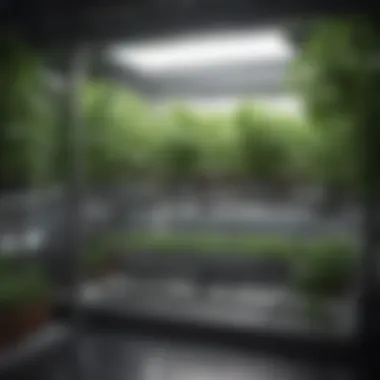
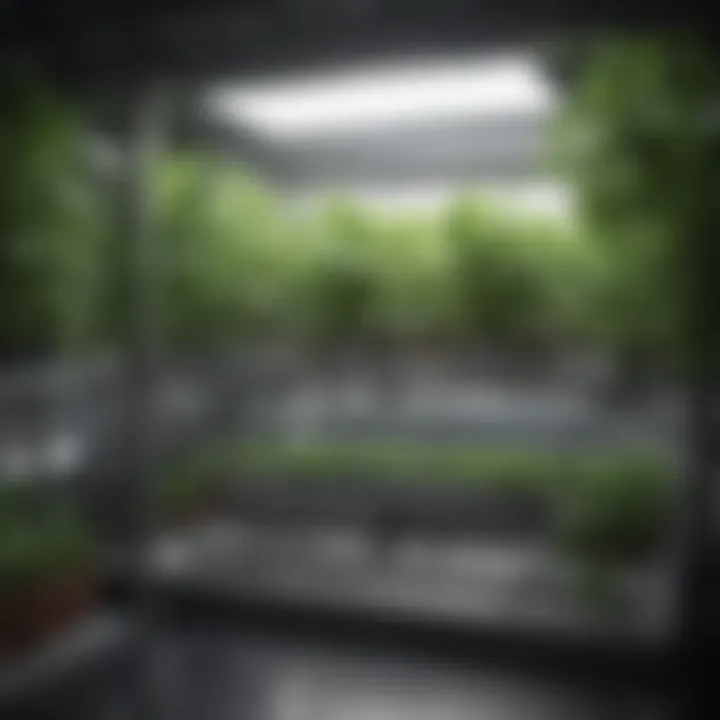
Automation significantly changes how hydroponics is managed. Various types of sensors can be utilized in an indoor grow box. These sensors continuously track crucial parameters:
- Nutrient levels: Ensuring the right concentration of nutrients for plant health.
- pH balance: Maintaining acidity levels within an ideal range to encourage nutrient uptake.
- Temperature: Monitoring growth conditions, as temperature drastically affects plant growth.
- Humidity: Regulating moisture levels to prevent mold or other growth issues.
The data collected via sensors can be sent to a central control system that automates watering, nutrient delivery, and light adjustments. This relieves growers from routine tasks, allowing them to focus on more critical aspects of cultivation. An automated system not only saves time but can also extend the growing season, enabling plants to thrive with less risk.
Hydroponic Applications of AI
Artificial Intelligence has immense potential within hydroponics. The introduction of machine learning algorithms into growing practices can revolutionize how growers approach their crops. AI can analyze data collected over time, learning from the outcomes of previous trials. Some applications include:
- Predictive analytics: Forecast outcomes based on existing environmental data to improve growth strategies.
- Plant health monitoring: Recognizing early signs of disease or nutrient deficiencies, prompting intervention.
- Optimized planting schedules: Determining the best times for planting, harvesting, and nutrient applications based on real-time data.
These AI applications enable users to maximize yields and minimize resource waste. The precise management of environmental conditions through intelligent systems is poised to drive the future of hydroponics forward. As more innovations emerge, the efficiency and output of indoor hydroponic systems will likely continue to grow.
Evaluating Economic Viability
Understanding the economic viability of a hydroponic indoor grow box is crucial for any potential grower. It encompasses an analysis of both the initial costs associated with setting up the system and the potential returns that can be expected over time. Many individuals might overlook this aspect, focusing solely on the technology or the plants they wish to grow. However, a well-rounded evaluation of the economic factors can ultimately determine the sustainability and success of hydroponic gardening.
The key benefits of evaluating economic viability include:
- Budgeting: Knowing how much to invest can help in making informed decisions about purchasing equipment and materials.
- Profitability Assessment: Understanding potential earnings enables growers to set realistic goals and strategies.
- Risk Management: A clear economic picture helps in identifying areas where costs can be minimized or where investments might not yield sufficient returns.
Thus, evaluating economic viability not only aids in planning but also enhances the grower's ability to adapt to market demands.
Initial Investment Costs
When starting a hydroponic grow box, initial investment costs play a significant role. These costs can vary widely based on the size of the system, the complexity of the setup, and the type of crops being grown. Here are some primary factors that contribute to the overall cost:
- Equipment: This includes the grow box itself, growing mediums, lights, water pumps, and nutrient solutions. Depending on brand and quality, prices can range significantly.
- Setup and Installation: If the grower is not assembling the system themselves, hiring professionals for installation can lead to additional expenses.
- Utilities: Electricity and water costs will begin to accrue once the operation starts. It's wise to factor these into the initial budget.
In total, initial costs can range from a few hundred to several thousand dollars, depending on individual choices. Understanding these numbers helps set realistic expectations before beginning the venture.
Return on Investment Analysis
The return on investment (ROI) analysis is another pivotal element when assessing the economic viability of hydroponic systems. This analysis measures the profitability of the setup over time, comparing the costs against the income generated from selling grown produce. Key considerations include:
- Revenue Generation: The type of plants grown directly impacts income. Fast-growing herbs like basil can yield quicker returns compared to slower growing vegetables.
- Market Prices: Local market trends can either enhance or hinder profitability. Knowing how to price the produce competitively is key.
- Operational Costs: Ongoing expenses, such as electricity usage for lights and pumps, will affect net earnings. A balanced approach toward maximizing growth while minimizing these costs is required.
Analyzing ROI allows growers to make informed adjustments to their business model. By tracking expenses against revenue, they can identify trends and make data-driven decisions moving forward.
In essence, an informed economic analysis not just prepares the ground for cultivation success but empowers growers to manage their hydroponic systems effectively.
Environmental Impact of Hydroponics
Understanding the environmental impact of hydroponics is crucial for acknowledging its potential benefits and drawbacks. Unlike traditional farming, hydroponics offers numerous advantages that align with sustainable agricultural practices. By minimizing land usage and optimizing resources, hydroponic systems prove to be a viable alternative for producing food in urban settings.
Sustainability Considerations
Sustainability in hydroponics focuses on reducing the environmental footprint associated with food production. Hydroponic systems use significantly less water compared to soil-based farming, which is a pressing concern in many parts of the world.
- Soil Conservation: Hydroponics does not rely on soil, thus alleviating soil degradation and erosion issues. This is particularly important as the global population continues to rise, placing additional pressure on arable land.
- Pesticide Reduction: These systems often employ integrated pest management strategies, minimizing the need for harmful pesticides that can leach into the ecosystem.
The ability to cultivate food in controlled environments allows for year-round production, reducing reliance on seasonal crops. This can lead to reduced transportation emissions since food can be grown closer to urban areas.
Water Usage and Conservation
Water conservation is a critical aspect of hydroponics. Conventional farming methods typically consume vast amounts of water, often leading to depletion of local water sources. In contrast, hydroponic systems utilize water more efficiently.
- Recirculation: Water in hydroponic systems is recirculated, meaning it can be reused multiple times. This closed-loop system minimizes wastage and maintains a constant supply of nutrients to the plants.
- Efficient Usage: Hydroponics uses about 90% less water than traditional agriculture. This efficiency is vital as the planet faces increased water scarcity.
The amount of water saved can lead to significant improvements in local water conditions, benefitting both human populations and wildlife.
Future Trends in Hydroponic Growing
Understanding the future trends in hydroponic growing is essential for anyone involved in agriculture, from hobbyists to commercial farmers. This segment focuses on how the evolution of hydroponics can shape growing practices and the overall market landscape. The developments in technology, combined with shifting consumer preferences and environmental considerations, will influence how hydroponic systems are designed and utilized moving forward. By exploring these trends, readers gain insights that can impact their own growing strategies.
Advancements in Hydroponic Technology
Recent technological advancements have revolutionized hydroponic systems. One major development is the integration of automation. Automated systems can monitor plant conditions, adjusting variables like light, nutrient delivery, and water levels in real-time. This not only saves time but also enhances plant growth consistency and quality.
In addition, sensors are becoming more sophisticated. Sensors that track moisture levels, pH, and nutrient concentrations provide data that helps in making informed decisions. This precise measurement leads to better plant health.
Also, the emergence of vertical farming systems is notable. These systems utilize limited space efficiently, increasing production yield without expanding the footprint of the operation. As urban areas grow, these technologies provide a solution for local food production. Incorporating hydroponics into these setups can result in fresher produce with a lower carbon footprint.
Market Growth and Consumer Demand
The hydroponics market is witnessing significant growth. As awareness of sustainable farming practices rises, more consumers are interested in hydroponically grown produce. There is a clear shift in demand for organic and locally sourced foods, reflecting a broader trend towards health-conscious eating.
Investments in hydroponics are increasing, driven by both consumer demand and the efficiency of hydroponic systems. Many traditional farmers are exploring hydroponics as a supplement to conventional methods, intrigued by its potential for higher yields and lower resource usage.
To summarize, the intersection of technology and consumer preference is shaping the future of hydroponic growing. The advancements in automation, sensors, and vertical farming are making the practice more viable. Meanwhile, the rising demand for healthy, sustainable food options is opening new opportunities for growers.
"The future of hydroponics is closely tied to how we embrace technology and respond to consumer needs."
As trends evolve, staying updated will be crucial for success in hydroponics. Recognizing these changes can help growers adapt and thrive in a competitive market.
Ending
The conclusion section is a vital piece of this comprehensive guide on hydroponic indoor grow boxes. It serves as the final opportunity to reinforce the key elements discussed throughout the article while summarizing the benefits and considerations relating to hydroponic systems.
One primary aspect to emphasize is the transformative nature of hydroponics in indoor gardening. As urban areas grow and land becomes limited, hydroponic systems represent a practical solution that optimizes space usage and resources. The ability to cultivate plants in a controlled environment allows for improved yields and reduced reliance on traditional farming practices.
Summary of Key Points
- Versatile Growing: Hydroponic systems provide flexibility in what can be grown indoors. This makes it ideal for both seasoned horticulturists and beginners who may want to start small.
- Efficient Use of Resources: Compared to soil gardening, hydroponics uses significantly less water and eliminates the need for pesticides, making it a sustainable option.
- Year-Round Gardening: Indoor grow boxes facilitate year-round production, regardless of external climatic conditions, enabling fresh food access at all times.
- Technology Integration: The incorporation of automation and monitoring systems enhances the overall management of the grow box, leading to more consistent results.
Final Thoughts on Hydroponic Indoor Grow Boxes
Hydroponic indoor grow boxes are not merely a trend. They represent a shift toward innovative gardening practices. Enthusiasts and those considering this method should understand the additional initial investment needed for setup. However, the potential returns—in terms of fresh produce and overall satisfaction—can be significant. With regular maintenance and proper care, these systems can flourish and offer a reliable source of nutrition.
In summary, embracing hydroponic growing can lead to a more sustainable lifestyle. As technology continues to advance, future prospects for indoor gardening look bright and filled with possibilities. This guide aims to equip readers with the knowledge needed to embark on or enhance their hydroponic gardening journey.



